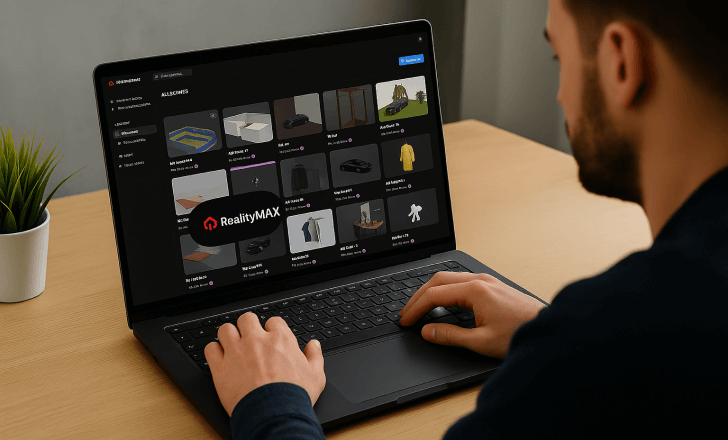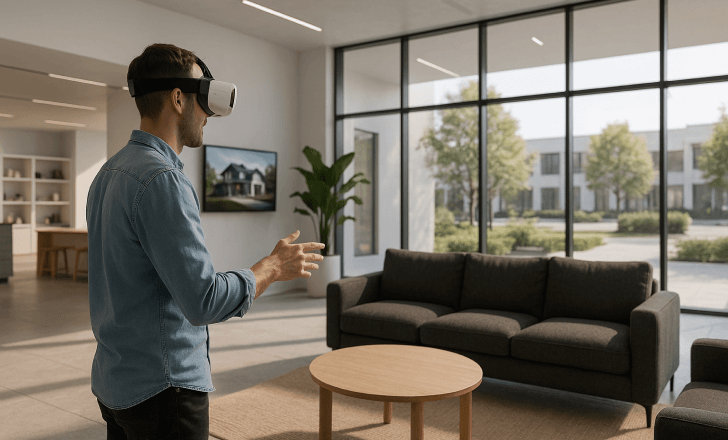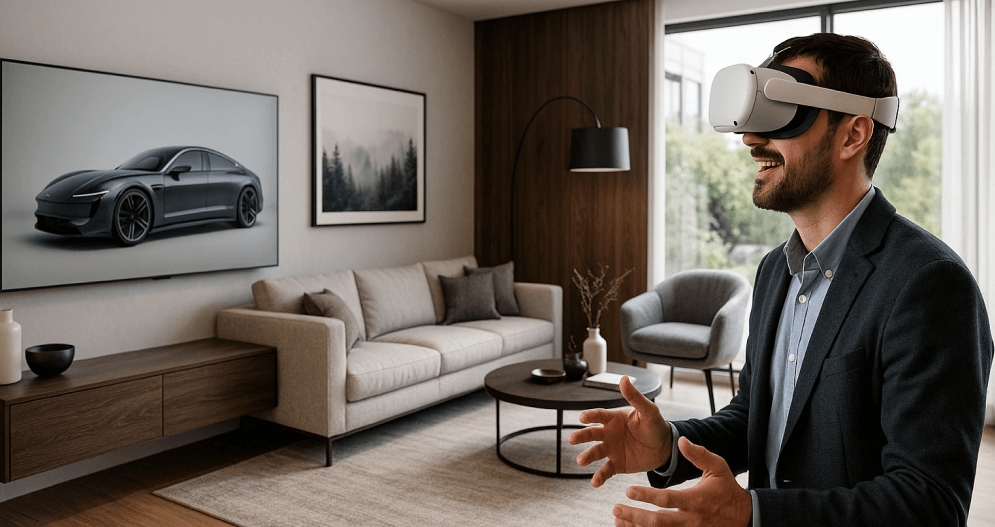Creating a digital showroom is an innovative, scalable way to sell. Whether you’re a fashion brand launching a new collection, a real estate firm showing listings remotely, or an automotive company simplifying buyer research, digital showrooms offer a powerful alternative to physical spaces.
In this guide, we’ll walk you through how to create a digital showroom that’s visually appealing, packed with useful features, and designed to increase sales across industries.
Why digital showrooms are reshaping retail and B2B
The digital transformation of retail and wholesale selling is accelerating. Physical showrooms come with high overheads and limited reach.
In contrast, a well-designed online showroom lets you attract global customers, showcase high-quality images and videos, and reduce your carbon footprint from a single platform.
Digital showroom software enables brands to present products in a virtual space with immersive technology, enabling multiple buyers to explore offerings simultaneously without needing to be on-site.
For many, this shift is not just about convenience; it’s a competitive necessity.

The benefits of creating your own virtual showroom
Let’s break down the core advantages:
- Scalability: Reach more potential buyers across geographies without expanding your physical footprint.
- Cost-efficiency: Save on travel, logistics, and venue costs.
- Better buyer experience: Let people interact with your product in 3D, see different angles, and even try out configurations, which is especially useful in the automotive industry or for furniture and fashion.
- Faster sales cycles: Engage, educate, and close, all in one place.
- Rich data: Learn from interactions and optimize your product offerings based on actual usage.
Choosing the right digital showroom software
The software you choose will shape the customer experience. Here are the key features to look for:
- 3D and AR compatibility: Essential for brands looking to provide interactive product visualization.
- Asset management: Crucial for fashion brands or companies selling many SKUs.
- Custom branding options: To reinforce your brand identity and values in every detail.
- Collaboration tools: These are useful for wholesale business models where teams of retail buyers are involved.
RealityMAX, for example, lets you create virtual showrooms with collaborative tools and immersive views that adapt to different industries.

Step-by-step: How to create a digital showroom
Now let’s get into the creation process.
Step 1: Define your goals and audience
Are you selling to retail buyers, potential homeowners, or fashion influencers? Clarifying your target audience helps determine your digital showroom’s layout, visuals, and flow.
Step 2: Curate your digital library
Gather high-quality visuals: 3D models, images from different angles, videos, and product descriptions. If you’re transitioning from a physical space, this is your moment to digitize physical samples into engaging, clickable content.
Step 3: Choose your platform
Pick a virtual showroom software that aligns with your needs. Look for flexibility, ease of use, and scalability. Consider whether you need virtual reality integration, support for static images and dynamic media, or backend tools for the ordering process.
Step 4: Design your virtual space
Structure the virtual environment with the same care as a brick-and-mortar store. Highlight your hero products, add interactive elements like zoom, rotate, or color swap features, and organize everything with user-friendly navigation.

Step 5: Launch and promote
Once your showroom is live, promote it via email campaigns, social media, and on your website. Consider embedding it directly into product pages or linking from digital catalogs to improve visibility and attract customers from search engines.
What industries benefit most from digital showrooms?
Fashion and apparel
Fashion buyers want more than static images. A digital showroom can showcase a new collection in motion, with detailed descriptions, videos, and even fabric simulations.
Diesel’s parent company, OTB Group, pioneered this digital shift, launching online showrooms to reach buyers globally, months ahead of market trends.

Real estate
Virtual tours are now expected. Digital showrooms let real estate agents offer interactive walkthroughs, share floor plans, and answer real-time questions, all without requiring a physical location visit.

Automotive industry
Online showroom platforms allow potential buyers to explore vehicles from different angles, customize features, and even start the buying process. It’s ideal for reducing friction and making the shopping process feel personal.
Home goods and furniture
Virtual store environments for furniture brands can replicate physical showrooms, allowing customers to visualize pieces in different styles, placements, and lighting, improving customer experience and reducing return rates.
B2B and wholesale
Wholesale business models thrive when they can cater to multiple buyers simultaneously. A digital showroom streamlines presentations, ordering, and inventory checks without the need for physical travel.
How does a digital showroom improve the buying process?
By giving potential buyers more control and clarity. Customers can zoom in on textures, read detailed product descriptions, and compare options side by side, reducing uncertainty and speeding up decisions.
Retail buyers can explore a brand’s products at their own pace or schedule guided sessions with sales reps. This flexibility helps shorten sales cycles and boosts conversions.

What are the best practices for an effective digital showroom?
- Start with a clear story: Let the showroom reflect your brand identity and highlight your product strengths from the first screen.
- Use immersive technology wisely: Don’t overcomplicate. Make sure navigation remains intuitive and purposeful.
- Keep visuals sharp: Invest in high-quality images and models. These are your stand-ins for physical samples.
- Update regularly: Launching a new collection or improving a product? Refresh your showroom to reflect it.
- Test across devices: Make sure your virtual showroom works just as well on mobile as it does on desktop.
- Use analytics: Track what buyers click, how long they stay, and what they ignore. Then iterate.
How do digital showrooms affect customer expectations?
Today’s customers expect immediacy, clarity, and a personalized experience. A digital showroom meets these expectations by making the shopping process feel more interactive, tailored, and transparent.
You create a stronger emotional connection and trust by allowing customers to explore all the details, from different colors to use cases, without needing physical store access.

Can virtual showrooms replace physical showrooms?
Depending on your business model, they can complement or replace them. Many brands now use hybrid approaches: a physical showroom for select flagship experiences and a virtual one to scale access and boost efficiency.
Digital versions reduce barriers and make your product accessible 24/7, especially for global retail buyers or remote customers. The experience can be just as personal with tools like annotations or collaboration.
What role does a virtual showroom play in reducing carbon footprint?
Traveling to a trade show, shipping physical samples, and maintaining large spaces all contribute to emissions. Virtual showrooms dramatically reduce this impact, making them a valuable part of any sustainability strategy.

How do I attract customers to my online showroom?
Start with strong visuals, but don’t stop there. Drive traffic using SEO, social media, newsletters, and industry platforms. Embed your digital showroom on product pages or link it to your online store to increase visibility.
Consider targeted campaigns for fashion buyers, automotive enthusiasts, or B2B leads, depending on your market.

What tools help manage the digital showroom experience?
Digital showroom software often includes:
- CRM integrations to track buyer interest
- Inventory management dashboards
- Video communication tools
- Analytics and heatmaps
- Content libraries for seasonal updates
Make sure your platform offers what you need, and not a bloated feature list you won’t use.
Want help setting up your own virtual showroom? RealityMAX gives you the tools to create high-quality, collaborative experiences tailored to your industry.
Whether you’re showcasing a new collection or streamlining wholesale selling, your showroom deserves to shine in the digital realm.
